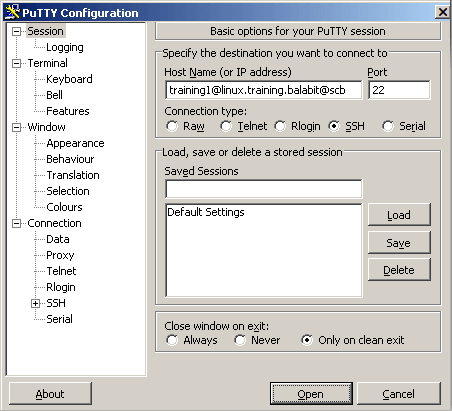To allow the administrators to access protected servers by connecting to the IP address of One Identity Safeguard for Privileged Sessions (SPS), and use the port number to select which server they want to access. Organizing connections based on port numbers is advantageous if SPS has a public IP address and the protected servers must be administered from the Internet.
For details on configuring alias IP addresses, see Managing logical interfaces.
To organize connections based on port numbers
-
Navigate to the Connections tab of the SSH Control menu.
-
Add a new connection. Enter the IP address of the administrators into the From fields, and the IP address and port number of the server into the Target field.
-
Enter the IP address of the logical interface of SPS into the To field, and enter a port number into the Port field.
-
Repeat Steps 2-3 for every protected server, but every time use a different port number in Step 3.
-
Click  .
.
To allow the administrators to access protected servers by connecting to an alias IP address of One Identity Safeguard for Privileged Sessions (SPS). The alias IP address determines which server they will access. Organizing connections based on alias IP addresses is advantageous if SPS is connected to a private network and many private IP addresses are available.
To organize connections based on alias IP addresses
-
Navigate to Basic Settings > Network.
-
Set up a logical interface: click  and configure a new logical interface. Add alias IP addresses for every protected server. (Use a different IP address for each.)
and configure a new logical interface. Add alias IP addresses for every protected server. (Use a different IP address for each.)
For more information on configuring logical interfaces and alias IP addresses, see Managing logical interfaces.
-
Navigate to SSH Control > Connections.
-
Add a new connection. Enter the IP address of the administrators into the From fields, and the IP address and port number of the target server into the Target field.
-
Enter an alias IP address of the configured logical interface of SPS into the To field.
-
Repeat Steps 4-5 for every protected server, but every time use a different alias IP address in Step 5.
-
Click  .
.
The following sections provide examples for using inband destination selection to establish an SSH connection, including scenarios where nonstandard ports or gateway authentication is used.
Since some client applications do not permit the @ and : characters in the username, alternative characters can be used as well:
-
To separate the username and the target server, use the @ or % characters, for example: username%targetserver@scb_address
-
To separate the target server and the port number, use the :, +, or / characters, for example: username%targetserver+port@scb_address
-
If you do not specify the username or the address in nontransparent SSH and Telnet connections, One Identity Safeguard for Privileged Sessions (SPS) displays an interactive prompt where you can enter the username and the server address.
In RDP, do not use the @ character as an inband data separator but use alternative characters, for example, the % character.
For detailed instructions on configuring inband authentication, see Configuring inband destination selection.
Topics:
To establish an SSH connection through One Identity Safeguard for Privileged Sessions (SPS) with PuTTY, follow one of the methods:
Common method
To establish the SSH-connection using the most common method, enter the username, the target server's hostname (or IP address), and the hostname (or IP address) of SPS using the <username>@<server>@<scb> format in PuTTY.
If you do not specify the username or the address in nontransparent SSH and Telnet connections, One Identity Safeguard for Privileged Sessions (SPS) displays an interactive prompt where you can enter the username and the server address.
Example
Assuming the following values:
You can enter the following destination in PuTTY:
training1@linux.training.example@scb
Figure 353: Configuring SSH inband destination in PuTTY

Alternative method
To establish the SSH-connection using a different method,
-
Enter only the hostname (or IP address, depending on your configuration) of SPS in PuTTY.
-
At the login prompt, provide the username on the target server, and the target server's hostname (or IP address) using the <username>@<server> format.
.

 and configure a new logical interface. Add alias IP addresses for every protected server. (Use a different IP address for each.)
and configure a new logical interface. Add alias IP addresses for every protected server. (Use a different IP address for each.)